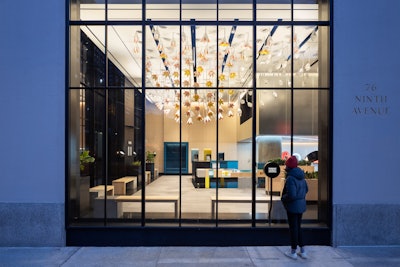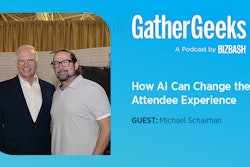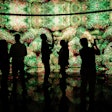
If you stop by Google’s office on Ninth Avenue in New York City, you’ll notice something unique: 160 electromechanical flowers that bloom as you interact with them. The eye-catching kinetic exhibit, which uses real-time sensing and machine learning to respond to visitors and passersby, is the work of Pittsburgh-based creative technology and experience design company Deeplocal, which has been incorporating artificial intelligence into events and activations for major brands for more than a decade.  During the day, the Google flowers bloom in two stages, reacting to the movement of people in the lobby below. In the evening, the choreography is cued by outside pedestrians. Click here to watch a video.Photo: Courtesy of Deeplocal
During the day, the Google flowers bloom in two stages, reacting to the movement of people in the lobby below. In the evening, the choreography is cued by outside pedestrians. Click here to watch a video.Photo: Courtesy of Deeplocal
Patrick Miller, Deeplocal's chief innovation officer, wants the industry to understand that while tools like ChatGPT are generating a lot of attention right now, there's so much more to AI than text and image generation. It's part of why the company recently launched Deeplocal.ai, a dedicated section of its website that emphasizes and explains its work with the cutting-edge technology.
"While so much of the industry races to understand and onboard AI-driven capabilities, we wanted to show that this is a tool we’ve successfully used for years," he explains. "Roughly half of our team are creative technologists: mechanical, electrical, and software engineers; roboticists; media systems experts; technical integrators; and more."
The goal is always to use AI and machine learning to create brand experiences that "feel magical yet relatable—through generation, detection, classification tracking, style transfer, and more," he continues. "Google Flowers is a great example of AI integration that makes an experience feel magical—without AI itself being the focal point."
 Patrick MillerPhoto: Courtesy of Deeplocal
Patrick MillerPhoto: Courtesy of Deeplocal
Deeplocal has been using AI for almost a decade. Are you finding more interest in it recently? Do clients need less convincing to use it, for example?
There has definitely been an explosion of interest, and it varies based on the client and their industries. Some of our core clients create AI platforms, so we’ve been helping them communicate the value of these platforms and tools through experiences that make the tech feel familiar and relatable. For them, the recent shift has not been in their interest in AI, but in their audiences’. Many of these platforms are consumer-facing, and people are becoming more interested to know how these AI tools and platforms are being leveraged as they become part of popular culture.
On the nontech side, we’ve never had to convince a client to use AI. We’re in the business of creating human experiences out of a client’s brand or platform. Sometimes we use AI tools to achieve that—but at the end of the day, it’s the experience that matters and the tools are simply the 'how.' We work as an extension of our clients’ marketing teams and build the trust that we’ll use the tools and solutions—AI or not—to achieve the vision.
What are some of your favorite ways you’ve created AI-driven moments for brands?
Our creative engineers work at the intersection of art and technology to invent real-world interactive experiences for brands. There’s an intrinsic joy in tactile interactions like pushing buttons, pulling levers, and turning dials, so we like to combine analog form factors with digital technologies like AI to create multisensory experiences that feel both magical and relatable.
For example: the [work we did for a] Flaming Lips concert at Google I/O. Anyone can listen to a perfectly recorded song at home for free, but concerts are a communal, singular experience. There’s an energy exchange between the band and the audience at a live show that creates long-lasting sense memories. We amplified that energy exchange and the magic of live music by creating an AI-powered musical instrument that combined Google Magenta’s Piano Genie model with a physical interface. To get the audience involved, we filled giant inflatables with sensors that signaled the software when touched, letting the crowd compose a song with the band in real time. AI helped make an already powerful human experience a completely unique and unforgettable one.
Another human experience that AI helps us elevate is connecting fan communities. When so much of life happens online or in front of a screen, bringing people together in person to celebrate their favorite things can be really special. The Adult Swim Rickflector brought Rick and Morty fans together at San Diego Comic-Con and gave them something to experience together, in person, and build on those relationships. Fans customized their own Rick and Morty-style avatars based on their likeness. Then, inside the Rickflector gaming pods, we combined body pose tracking and facial expression tracking to transport Comic-Con attendees into the world of the show. With the help of AI, the avatars moved and responded in unison with players’ own actions, bringing the cartoon universe to life in highly personalized ways.  Before entering the Rickflector pod at Comic-Con, fans customized a character based on their own likeness to create an avatar. Inside, their avatar’s DNA was scrambled with that of a popular Rick and Morty character, which came to life in one of five games set in the world of the show.Photo: Courtesy of Deeplocal
Before entering the Rickflector pod at Comic-Con, fans customized a character based on their own likeness to create an avatar. Inside, their avatar’s DNA was scrambled with that of a popular Rick and Morty character, which came to life in one of five games set in the world of the show.Photo: Courtesy of Deeplocal
Are there any drawbacks to using AI at events?
There are a lot of ways someone may use AI at an event; it’s helpful to differentiate them a bit. First, if we focus on creating experiences at events, at the core, these experiences should be things that people want to interact with. Playful, tangible interfaces are an important complement to advanced digital tech. Second, every experience should be authentic and intuitive to the brand—not just a brand name slapped on a commodified interaction.
Experience creators should be wary of leaning too heavily on popular tech as a shortcut to creating something novel. So not so much a drawback of AI specifically, but an overuse of tech for tech’s sake in the pursuit of novel experiences is something the industry needs to watch out for. The bar of what is magical continues to rise, and, in exchange for consumers’ time and effort, we should be delivering experiences that resonate and intrigue, not shoehorn whatever is driving the headlines. It’s a win-win for both clients and their customers.
What would you say to people who think AI is replacing human jobs?
The risk is somewhat lower in experiential marketing because interacting with other humans is usually an integral part of the experience. In general, when we are talking about the arts there is still an appreciation for the human component in the creation process. People tend to value artistic things less when they are solely AI-generated or the decision-making in the artistic process has been offloaded to AI. There isn’t a large audience for watching different AI chess algorithms play each other—but people still love watching human players play, even if it can be argued that their skill is inferior. These things matter for people because of the human element, not just the quality of the output or skill level. There is an appreciation for the human effort and journey that goes into these things, and we should use AI as a tool to empower versus replace in these instances.
Our project with Google and The Flaming Lips is a good example of this. AI made something possible that wasn’t easily achieved before, but it was the human connection that mattered and why people cared.  At Google I/O in 2019, headliner The Flaming Lips incorporated AI into their performance. The result was Fruit Genie: an AI-powered musical instrument that combined Google’s Magenta model with a physical interface of fruit. The band used Piano Genie software to compose a new song for the I/O performance; to get the audience involved, giant inflatables were filled with sensors that signaled the software when touched, adding notes to the song.Photo: Courtesy of Deeplocal
At Google I/O in 2019, headliner The Flaming Lips incorporated AI into their performance. The result was Fruit Genie: an AI-powered musical instrument that combined Google’s Magenta model with a physical interface of fruit. The band used Piano Genie software to compose a new song for the I/O performance; to get the audience involved, giant inflatables were filled with sensors that signaled the software when touched, adding notes to the song.Photo: Courtesy of Deeplocal
Any predictions for the future of AI in events and experiential marketing?
I think we will see a lot of benefits around personalization in the event space. While things will feel custom and seamless, it’s important for the industry to be transparent around data use and the value exchange for data—again, keeping the end user in mind when crafting an experience or event.
We also see this as a space that will keep growing and become a larger part of brands’ marketing tactics. AI helps us create more personal, immersive, and robust experiences that deliver a higher return on emotion in consumers. It also takes some of the friction out of the creation process and will enhance the power of adjacent systems. Think: less time spent on boilerplate coding tasks, zero wait time for customer support, and replacing repetitive tedium with more time for creation and experimentation.
Ultimately, AI is opening up a new range of possibilities in experiential and event marketing, and we’re only just beginning to see what that will look like in the years to come.



















